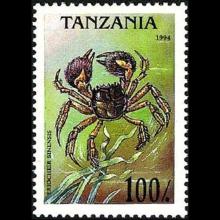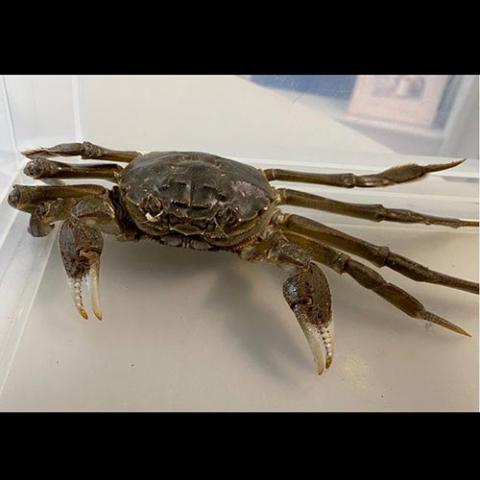NAMES
TAXONOMY
Tanzania
Issued:
Stamp:
Eriocheir sinensis
Tanzania
Issued:
Stamp:
Eriocheir sinensis
Tanzania
Issued:
Stamp:
Eriocheir sinensis
BERLIN (AP) October 8, 2020 — Police in southern Germany say a woman got a shock while airing out her home when a 25-centimeter (10-inch) Chinese mitten crab scurried in from the terrace through the open door.
Freiburg police said Thursday that they received a call reporting the unwanted home invader in the nearby town of Unterlauchringen, near the Swiss border, the previous morning.
Before they arrived, police say, the woman captured the crustacean by putting an upside-down garbage can on top of it.
Officers were able to put the crab into a container and then take it to a local veterinary clinic.
The invasive species, native to Asia, is now found in many rivers in Germany, and the woman’s residence was not far from the Rhine, though the Chinese mitten crab has never been reported in the area before. They’re not considered dangerous.
Genus species (Animalia): Eriocheir sinensis
Eriocheir sinensis (Common name: Chinese mitten crab) also known as the Shanghai hairy crab (上海毛蟹, p Shànghǎi máoxiè), is a medium-sized burrowing crab that is named for its furry claws, which resemble mittens. It is native to rivers, estuaries and other coastal habitats of East Asia from Korea in the north to Fujian, China in the south. It has also been introduced to Europe and North America, where it is considered an invasive species.
Culinary
The crab is an autumn delicacy in Shanghai cuisine and eastern China. It is prized for the female crab roe, which ripen in the ninth lunar month and the males in the tenth. The crab meat is believed by TCM practitioners to have a "cooling" (yin) effect on the body.
Chinese spend hundreds of yuan just to taste a small crab from Yangcheng Lake, which are considered a delicacy. Most of the Yangcheng crabs are exported to Shanghai and Hong Kong, and high-profit foreign markets. Responding to the spread of the crab to the West, businessmen have started seeing it as a new source of crab for the Chinese market. One proposed scheme involves importing unwanted crabs from Europe, where they are seen as a pest, to replenish local pure-bred stock.
Mitten crabs have exhibited a remarkable ability to survive in highly modified aquatic habitats, including polluted waters. Like some fish, they can also easily tolerate and uptake heavy metals, such as cadmium and mercury. Therefore, the farming and post-harvesting of the species needs proper management if it is used as a food. Concerns have been raised that the population and origin of the crab may be affected because of overfishing of the species in the Yangtze.
Recently, a Chinese businessman introduced vending machines to sell this species of crab in the subways. The crabs are stored at 5 °C (41 °F), which induces a sleep-like state.
Reference: Wikipedia


